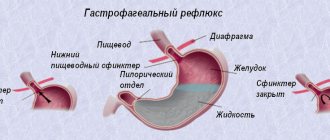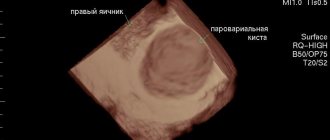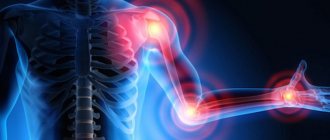Neuroma is a benign tumor formed by cells of the myelin sheath of nerve trunks. These cells are called Schwann cells, so the second, no less common name for neuroma is schwannoma, so as not to be confused with neuroma, which belongs to a different type. This type of tumor is also known as schwannoglioma (Schwann cells of glial tissue), neurilemmoma, perineural fibroblastoma, lemmoblastoma, neurinoma. The tumor is in most cases a single node, less often multiple nodes of dense consistency, with a clear demarcation from healthy tissue. A benign tumor increases in size slowly, its growth is restrained only by the surrounding dense tissue; where growth is not too limited, for example, in the mediastinal space, the node can reach a significant size; neuromas weighing 2.5 kg are described in the medical literature.
Neuromas can appear on any nerve trunk, and since nerve tissue is found in all parts of the body without exception, neuromas can appear in any part of the body. However, their favorite localization is the spinal cord and auditory nerve. Acoustic neuromas account for about 8% of all brain tumors, and spinal neuromas, i.e. spinal cord – up to 20% of all tumors of this organ. This type of tumor occurs in all age groups, including children; for an unknown reason, neuroma affects more women than men.
Etiology of neuroma of the brain
Neuroma is formed from auxiliary Schwann cells of nervous tissue. May be localized in the eighth or fifth cranial nerve. In most cases, the formation is benign, but malignant manifestations of the disease can also occur.
Experts were able to determine the cause of neuroma from a scientific point of view. This occurs as a result of mutation of some genes on chromosome 22, which are responsible for protein synthesis, which limits the tumor growth of Schwann cells. Improper synthesis leads to their excessive growth and proliferation. However, the very reasons why mutations occur have not been clarified, but there are suggestions that neuroma is formed as a result of the following factors:
- genetic predisposition. If one of the relatives in the family was diagnosed with neuroma, then in 50% of cases the heirs may also develop a similar disease. Human cells have the ability to divide uncontrollably under the influence of certain factors: stress, radiation, taking medications, etc. The division process causes the occurrence of tumors and the development of various types of ailments;
- disorders in the immune system. Human immunity is needed to fight various foreign microorganisms that can harm the body. A decrease in protective functions leads to the occurrence of diseases, including neuroma. The reasons why immunity decreases are different: living in an area with a poor environment, poor diet, constant stress, bad habits, etc.;
- exposure to radiation for a long time, especially in childhood, can eventually lead to the development of tumors in the brain;
- the presence of other benign formations.
In addition, constant inflammatory processes in the body lead to the disease, for example, with tonsillitis, pharyngitis and nasopharyngitis.
Forecast
Neuroma has a favorable prognosis if you seek medical help in a timely manner. A tumor located in the brain, if left untreated, can lead to death due to the destruction of vital structures. Tumors located in other parts of the body also cause disruption of the functioning of various organs. This type of tumor responds well to treatment, therefore, after adequate treatment of neuroma, relapse, as a rule, does not occur.
In extremely rare cases, neuromas can malignize, that is, become malignant. Then the prognosis directly depends on how quickly and completely the neuroma was removed.
Types of pathology
There are several types of cerebral neuroma depending on the features of its structure:
- epileptoid - formations in the form of a dense body with a large number of fibers;
- angiomatous - provokes abnormal dilation of blood vessels, which leads to the formation of a large number of cavernous cavities;
- xanthomatous - formations acquire a yellow-gray, yellow or green color due to the fact that the tumor cells contain a lot of pigment.
Because these neoplasms arise in different sites, there is no precise classification based on location.
Symptoms of the disease
If the tumor affects the anterior nerves, paralysis of the limbs develops. When a knot forms on the posterior nerves in the muscles, there is constant tingling and numbness in certain areas. Schwannoma manifests itself depending on the location:
- Neuroma of the thoracic spine is characterized by pain between the shoulder blades. The affected nerve provokes breathing problems due to severe pain when the open lungs press on the nerve root. The disease may be confused with osteochondrosis.
- With cervical neuroma, the patient experiences throbbing pain when tilting the head. A compressed spinal root causes severe headaches. Shooting pain occurs in the collarbone and shoulder, radiating to the arm.
- The lumbar region and the sacral region are responsible for the movement of the lower extremities and the functioning of the excretory system. A benign process in the lower back is manifested by girdle pain. If the tumor is large, it can put pressure on a neighboring organ. Over time, the patient develops uncontrollable bowel movements and urination. A compressed nerve does not allow you to feel the urge and restrain natural processes. Pain is noted in the retroperitoneal cavity. The tumor is extraorganic, so the discomfort is not associated with the internal organs.
- In addition to pain, a symptom of atrophying muscle occurs in a numb limb.
- The tumor can grow into the intervertebral spaces and deform the bones. The process is accompanied by acute pain. The patient notes changes in appearance, the inability to put his head in a normal position.
- The pain syndrome intensifies when taking a supine position. At first, the pain is periodic and varies in intensity. As the tumor grows, the pain becomes permanent. A person experiences acute attacks, nagging and throbbing pain. Analgesics are not able to eliminate sensations for a long time.
A person develops a depressive state and increased nervousness. In some cases, consultation with a psychologist is necessary.
Malignant neuroma is dangerous due to the appearance of secondary lesions in all parts of the body. Symptoms will expand due to the organ with metastases. At the last stage, general symptoms of intoxication will develop:
- Weight loss;
- Nausea;
- Lethargy;
- Vomit;
- Fever;
- Body pain and aches;
- Bleeding.
Clinical manifestations of neuromas of various localizations
Based on location, neuromas are divided into:
- acoustic neuroma;
- trigeminal neuroma;
- neuroma of peripheral nerves.
Depending on the location, the symptoms of the disease vary, requiring individual treatment for each case.
Acoustic neuroma
In most cases, the auditory nerve is affected on one side, and symptoms are observed only on that side. In those rare cases where the neuroma is bilateral, symptoms develop on both sides. Signs of this disease include:
- Ringing in the ears is the first symptom that is observed in 80% of patients, even with a small tumor. Depending on the location, the ringing is heard from one or both sides;
- Hearing loss is a symptom that affects almost everyone who has encountered a neuroma. Develops gradually, starting with high sounds. It also appears depending on the location of the tumor;
- loss of coordination - affects almost half of all patients. The symptom is characteristic of the later stages of the development of the disease, when the tumor has exceeded its size by 3-3.5 cm;
- a headache with a neuroma occurs if the tumor compresses the nerve endings in the brain;
- dizziness occurs on its own, but more often in combination with nausea, vomiting and loss of consciousness.
Tinnitus is one of the symptoms of acoustic neuroma.
The clinical picture can give an assessment of the stage of the disease. At the first (initial) stage, the formation measures up to 2 cm. It is manifested by a decrease in the function of the trigeminal, facial and vestibulocochlear nerves.
The second stage is characterized by an increase in the tumor to 2-4 cm. It begins to put pressure on the brain stem and cerebellum. Complete loss of hearing, taste, and paralysis of the trigeminal and facial nerves is possible.
The third (advanced) stage occurs when the tumor exceeds 4 cm. In this case, the damage to the cranial nerves is accompanied by intracranial hypertension syndrome, speech is impaired, swallowing becomes difficult, and cerebellar disorders become clearly expressed.
Trigeminal neuroma
It is the most common neuroma among the others. Signs vary depending on the size of the tumor:
- impaired sensitivity on the face, characterized by crawling goosebumps, numbness, and a feeling of coldness;
- weakening of the masticatory muscles;
- pain at the location of the formation;
- disturbance of taste sensations;
- hallucinations in terms of taste and smell.
These symptoms appear in 15% of cases on the affected part of the face at the very beginning of the disease. As it progresses, dysfunction of the masticatory muscles occurs. Damage to the trigeminal nerve indicates that the tumor has exceeded 2 cm in size.
Neuroma of peripheral nerves
With neuroma of the peripheral nerves, the tumor is usually located superficially and grows extremely slowly. Symptoms depend on the organ affected by these nerve endings. As a rule, neuroma is one-sided, represented by a single small round-shaped compaction along the nerve.
The main sign of the development of peripheral nerve neuroma is pain that occurs along the nerve and intensifies when pressure is applied to it. The nature of the pain can be different: sharp, shooting, causing numbness. The next symptom of this type of tumor is sensory disturbances. They manifest themselves in the form of numbness, crawling or a feeling of slight chilliness in the area where the nerve ending is located. Gradually, muscle weakness and impaired motor activity join the symptoms if the neuroma develops in the extremities.
Methods for diagnosing the disease
An experienced neurologist or neurosurgeon will help diagnose neuroma. To reduce the range of examinations and financial costs, it is very important to cooperate with the doctor, help him during the diagnosis and establish the correct diagnosis.
During the first visit, the most complete anamnesis of the disease is collected, which includes all kinds of complaints, anamnestic data about the disease of interest and the collection of all information about habits and concomitant pathologies, past diseases. A correctly collected anamnesis is 50% of success in correctly determining the diagnosis.
After the conversation, the doctor conducts an objective examination, which includes identifying concomitant pathologies of other organs, as well as examination, palpation, percussion and auscultation of the affected area.
After all the stages, a preliminary diagnosis is established, on the basis of which a plan for further examination is built. It includes laboratory and instrumental studies that will definitely help confirm or refute the suspected pathology.
Instrumental methods that will help identify the presence and stage of neuroma include:
- Audiogram;
- Electromyography;
- Ultrasound examination using Doppler monitoring;
- X-ray examination;
- CT scan;
- Magnetic resonance imaging;
- Fine-needle targeted biopsy.
It is not necessary to carry out the entire list of these instrumental studies; the doctor himself will choose the most informative methods for him. The main thing is the completeness of the picture and a clear concept of malignancy, stage and degree of compensation of the process.
After all, having complete information will help you choose the most optimal comprehensive treatment and determine the likely degree of risk and the need for surgical intervention.
In addition to interviews, doctors prescribe special examinations to patients, on the basis of which a final diagnosis is made.
Table. Basic diagnostic methods.
| Diagnostic method | Short description |
| Radiography | The traditional method of diagnosing the condition of bone tissue, devices are available in the vast majority of clinics. Modern X-ray machines make it possible to obtain clear images in which all pathological changes in the spine are clearly visible. Radiography gives a general idea of bone changes in the affected area. |
| CT scan | More modern equipment for diagnosing bone tissue; in some cases, to obtain the most complete information, a contrast agent is injected into the circulatory system of patients. After the examination, the doctor takes a series of cross-sectional photographs taken in increments of approximately 3 mm. The images are processed by a special computer program; as a result, three-dimensional images are obtained that can rotate around an axis. Due to this, you can notice the smallest pathological abnormalities in tissues and make the correct diagnosis. |
| Magnetic resonance imaging | Medical devices of the latest generation are manufactured using innovative technologies. The body is irradiated with magnetic waves - the negative consequences that occur after X-ray examinations are completely eliminated. MRI shows the condition of not only bone, but also soft tissue. |
| Ultrasound | The reflected ultrasonic waves are displayed on the monitor of the device and show the actual condition of the internal organs and tissues. Modern ultrasounds have special programs that allow you to assess the condition of internal organs and compare their parameters with standard ones. This almost completely eliminates the negative influence of the human factor and increases the reliability of the diagnosis. |
| Biopsy | The most difficult of all the examinations described above. The invasive procedure makes it possible to obtain a piece of the affected tissue; samples of the neoplasm are subsequently sent for histological examination. This is the only way to confirm the type of tumor with 100% certainty and prescribe the optimal treatment. Disadvantage - there is a slight risk of negative consequences due to mechanical damage to the nerve endings. |
Biopsy needle
Neuroma (or schwannoma) is a benign tumor that forms in Schwann cells of the spinal, cranial and peripheral nerves. Thus, a neuroma is a growth in the cells that cover the nerves. They are round, sometimes lobular, capsule-shaped formations.
They appear most often in the root of the auditory nerve (vestibular portion), progress in the cerebellopontine angle (facial and auditory nerves), less often in the root of the V nerve (maxillary and mandibular, orbital nerves). And extremely rarely, neuromas arise in the roots of the glossopharyngeal and vagus nerves.
The percentage of neuroma disease is relatively small and accounts for about 8% of all intracranial neoplasms and about 20% of all primary spinal formations. Middle-aged and older people are susceptible to this disease, with women getting sick more often. Because Since neuroma is a benign tumor with slow growing growth, it very rarely develops into a malignant tumor.
1. Morton's neuroma. This benign tumor forms in the area of the plantar nerve of the foot. In most cases, it occurs at the site of the nerve of the third and fourth toes, sometimes between the second and third toes. It mainly affects one foot, very rarely both.
2. Acoustic neuroma (also called vestibular schwannoma). In most cases, such a tumor arises in the vestibular branch of the auditory nerve, and its growth continues in the cerebelloptine angle. The neuroma increases in volume, resulting in pressure on the cerebellum and brain stem. Direct contact of the mass with the facial nerves sometimes even affects the lower cranial and trigeminal nerves.
There are unilateral acoustic neuromas (about 95%) and bilateral (5%). The latter is usually caused by neurofibromatosis, and its first manifestations are possible already in the second decade of life, in contrast to unilateral, which most often affects people aged 40-50 years.
3. Spinal neuroma. It is caused by a tumor of the spinal nerve roots, and in most cases occurs in the thoracic and cervical region, less often in the lumbar region. It is considered the most common disease of primary neoplasms on the spinal cord. Develops as an extramedullary-intradural tumor in Schwann cells.
Neuromas of the spinal roots can spread through the intervertebral foramen extradurally. This form of neuroma is of the “hourglass” type and is characteristic of the cervical spine. The consequences of spinal neuroma are bone changes, which are diagnosed by conventional spondylography.
Neuroma of the trigeminal and other nerves is a consequence of a tumor of the auditory nerve, and such a type as mediastinal neuroma is a subtype of tumor on the spine.
A neoplasm, both benign and malignant, can occur in almost any part of the body.
One of the types of benign formations is spinal neuroma (schwannoma). The ICD 10 code is D36.1.
It consists of the myelin sheath of the spinal cord nerves (Schwann cells).
The tumor process can develop at any age. Middle-aged and older women are most susceptible to pathology. The development of a spinal neuroma can occur over many years and not make itself felt.
As a rule, a neoplasm does not pose a great danger to the body as a whole. But due to the peculiarities of its location, compression of the central nervous system structures leads to a significant decrease in the patient’s quality of life.
Neuroma can develop not only in the area of the spinal roots, but also cause damage to other nerve endings (for example, auditory nerves).
Therefore, it is imperative to treat neuroma so that it does not lead to even more problems.{amp}lt;p{amp}gt;
The tumor has a dense consistency, oval or irregular, tuberous shape. The neuroma is surrounded by a fibrous capsule or connective tissue.
Thanks to such a capsule, the tumor does not grow into surrounding tissues and does not metastasize.
Although this type of tumor is considered benign, its transformation into a malignant formation cannot be 100% ruled out.
Predisposing factors can trigger the onset of tumor growth:
- heredity;
- exposure to ionized rays;
- injuries leading to damage to nerve roots.
The growth of the tumor is quite slow. When it reaches a large size, it can protrude beyond the spinal column. Neuroma can reach a weight from several grams to 3-5 kg.
Most often it forms in the cervical and thoracic regions. The process of tumor growth in the spinal nerves of the cervical spine can develop in an “hourglass” pattern.
It grows into soft tissue through the vertebral foramina and can be visualized under the skin.
Types of education
The following types of neuromas are distinguished based on their location:
- cervical;
- chest;
- lumbar
In some cases, the tumors are multiple and appear throughout the spine.
Based on the structure of schwannoma, the following forms can be distinguished:
- epithelioid - characterized by a dense arrangement of cells with a small number of tissue fibers;
- angiomatous - has many cavernous cavities that were formed as a result of pathological dilations of blood vessels;
- xanthomatous - has many pigment cells.
Clinical picture
Many years may pass before the first symptoms of schwannoma appear. Therefore, the pathology is characterized by a long asymptomatic course. In the initial stages of the disease, dull pain in the affected area may periodically appear.
As the tumor progresses, it compresses the surrounding tissues, which causes the appearance of negative symptoms:
- increased pain in the back and limbs;
- muscle atrophy and weakness;
- deterioration of motor function and sensitivity below the tumor location (paresis, paralysis);
- numbness in the limbs;
- parasthesia (“goosebumps”, numbness in the limbs, burning);
- dysfunction of the pelvic organs;
- sexual dysfunction.
Diagnosis of neuroma
Diagnostic measures for cerebral neuroma depend on its location. At the appointment, the doctor interviews the patient to create a complete clinical picture. An examination by a neurologist, instrumental and laboratory tests are also carried out, which include:
- cerebral neuroimaging, consisting of MRI and CT. With their help, the presence of a tumor, its size and the condition of nearby tissues are recognized;
- radiography reveals bone changes that occur against the background of tumor growth;
- Ultrasound diagnostics is a fairly informative method that shows changes in the soft tissues near the tumor;
- audiometry is prescribed to determine hearing impairment due to a tumor of the auditory nerve;
- a biopsy is performed to conduct histological studies of a tumor fragment.
CT scan is one of the methods for diagnosing cerebral neuroma.
The patient is also prescribed a number of generally accepted blood and urine tests to exclude an inflammatory process in the body.
Conservative treatment
Funds may be prescribed in the form of:
- diuretics (Prednisolone, Mannitol);
- myoleraxants (Sirdaluda, Mydocalma).
- glucocorticoids.
Such drugs not only eliminate swelling, but also stop tumor growth and relieve pain. An important nuance is minimal consumption of water and salt.
It is also advisable to drink herbal teas. Be sure to adhere to the recommended doses. They are determined by the doctor, according to the stage, location, and age of the patient. Self-medication is excluded.
There are patients to whom the above methods cannot be applied. The reason may be the presence of very severe concomitant pathologies, extremely large tumor sizes, poor health, extreme old age, etc. For them, expectant management is used with a set of special medical measures to improve the quality of life. Treatment includes taking painkillers and regularly monitoring the development of neuroma.
With expectant management, painkillers are prescribed
Treatment of neuroma
If there is a brain neuroma, treatment is prescribed only after diagnosis and determination of its type and location. The only way to be cured is to remove the tumor from the body using one of the existing methods.
Surgical removal of neuroma
Carrying out surgery to remove the tumor is the main and perhaps the most reliable method that will be offered to the patient. For small neuromas, microsurgery may be performed to preserve the functionality of the auditory and facial nerves.
If the operation is performed in the skull, then a suboccipital, transverse temporal or translabyrinthine approach is used. If the tumor fuses with nerve fibers, it is partially removed, but in this case relapses are possible. A large brain neuroma can only be removed by craniotomy. In this case, there is a high probability of side effects such as hearing loss or facial paralysis.
Radiation therapy
In cases where surgery to remove a brain neuroma is not permitted, the doctor prescribes radiation therapy. Contraindications to surgery may be in the following cases:
- location of the tumor in a hard-to-reach place;
- the tumor is located next to a vital organ;
- the patient's age exceeds 55 years;
- heart disease;
- renal failure;
- diabetes.
Radiation therapy is a method of treating cerebral neuromas.
Radiation therapy is used for unadvanced malignant tumors. After its implementation, the tumor does not degenerate into metastasis and the prognosis for life is very favorable.
Radiosurgical treatment method
Radiosurgery is prescribed when the tumor is located inside the skull or when it is located in the spinal cord. Targeted radiation causes the death of some tumor cells. Those that remain lose their ability to reproduce on their own. Radiosurgery is possible when the size of the neuroma is no more than 3 cm. In other cases, the method is used as palliative treatment in order to reduce the size of tumors if open surgery is contraindicated.
Diagnostics
Neuromas can be detected not only by characteristic symptoms, but also using diagnostic procedures such as:
- Neurological examination.
- Audiograms.
- Computed tomography.
- NMR.
The main symptoms for diagnosis may be muscle weakness, stiffness in movements, sensory disturbances, and increased tendon reflexes. However, for an accurate diagnosis, CT and NMR are the most informative. In this case, the diagnosis is made not only by the signs of neuroma, but also by the detection of a tumor in the images.
Possible consequences after cerebral neuroma
The complications that a cerebral neuroma can cause depend on its location and size. Small formations that were promptly treated with radiotherapy do not provoke serious consequences. But if the tumor has reached a large size and has compressed certain parts of the brain, various complications arise:
- one- or two-sided deafness;
- paralysis;
- facial nerve paresis;
- cerebellar disorders;
- intracranial hypertension.
The most dangerous complication of a benign tumor is its degeneration into a malignant formation. In this case, with a cerebral neuroma, the life prognosis becomes unfavorable.
Causes
Neuroma on the spine or in the cauda equina region never appears on its own, but it has not yet been possible to fully understand what can trigger its development. The main reason is the proliferation of Schwann cells, which gave the second name to this pathology.
It is reliably known that one of the reasons for the onset of the development of a tumor process is a mutation of genes on chromosome 22, but the reasons for this mutation themselves remain in question. Today, some provoking factors are known that can cause this pathology. These primarily include:
- Exposure to radiation.
- Prolonged contact with various chemicals.
- Diagnosis of neurofibromatosis type 2.
- Hereditary predisposition to tumors.
- Presence of other tumors.
Genetic predisposition also plays a huge role in pathogenesis, especially if either parent is diagnosed with a disease such as neurofibromatosis type 2.
Prevention of neuroma
There are no specific methods for preventing neuroma. General measures boil down to preventing exposure to negative factors that can cause the disease and increasing antitumor immunity. These include:
- rejection of bad habits;
- good nutrition;
- refusal of self-medication;
- timely consultation with a doctor in case of illness;
- reduction of stressful situations;
- strengthening the immune system.
By following preventive measures, you can reduce the likelihood of uncontrolled cell division and the appearance of tumors.
https://youtu.be/wiG75w2mvrY
Consequences
The main consequences can be considered paresis and paralysis, while paralysis is a complete absence of movement, paresis is a weakening of voluntary movements. They develop due to the growth of a tumor when it compresses the spinal cord. If the compression is insignificant, paresis develops; if it is strong, paralysis develops.
Paresis or paralysis can occur in one limb (monoplegia, monoparesis), or it can affect both arms or both legs (paraplegia, paraparesis). In addition to movement disorders, muscle weakness and trophic changes are noted.
Diagnosis of a tumor in the spine
The choice of treatment method depends on the stage of the disease. Unfortunately, most benign formations begin to make themselves known only after they reach large sizes or cause complications in the body. With this development of the situation, the doctor can only surgically remove the formation.
However, there are cases when it is possible to use conservative therapy. As a rule, such situations are observed in patients who regularly undergo health examinations and monitor their well-being.
The simplest and most inexpensive way to identify pathology is an x-ray. It is prescribed at the beginning of diagnostic procedures to differentiate the tumor from degenerative pathological processes with similar symptoms. Instead of an x-ray, you can immediately do a CT scan. After a complete diagnosis, treatment is prescribed.
The prognosis of neuroma is considered favorable, since surgery allows for complete healing and restoration of the functional state of the affected area. Inoperable forms of neuroma do not pose any particular health hazards due to the encapsulated growth of a benign neoplasm, which prevents serious damage to nearby tissues.
Even a benign tumor of the spine can have dangerous consequences for human health. It can compress spinal nerves, which can lead to:
- partial loss of motor functions;
- disruptions in bowel function;
- dysfunction of the urinary system.
In addition, schwannomas can degenerate into malignant tumors, and this is potentially dangerous not only for health, but also for human life.
Diagnosing malignant schwannoma is difficult because the tumor is rare and the symptoms it causes are similar to other more common diseases. To identify neurological disorders, special tests are performed for sensitivity, reflexes, coordination of movements, etc. This way the doctor can understand how the nerve is damaged.
To exclude other (non-oncological) diseases and confirm the diagnosis, the following methods are used:
- X-ray. The classic X-ray findings of a malignant schwannoma are a well-confined mass that displaces adjacent structures without directly invading them. Cystic degeneration is characteristic, but hemorrhages and calcification are very rare. X-rays are also used to examine the chest, mediastinum, and spine.
- Computed tomography. CT is not as sensitive as MRI in diagnosing neuroma, but is often the first test. CT is especially useful in assessing bone changes and looking for lung metastases.
- MRI. It will help determine the exact location of the tumor, its connection with the nerve and surrounding tissues.
- Biopsy. A sample of the tumor is taken using a special needle and examined in a laboratory to determine its origin and malignancy. A biopsy is not required if doctors are confident that the neuroma is benign (it grows slowly and has clear boundaries).
Depending on the location of the tumor, additional studies may be needed. For example, myelography is used to study the spinal cord and its structures (including nerve roots), and if the auditory nerve is damaged, audiometry, that is, a hearing test, is prescribed.
Surgery for malignant schwannoma usually quickly relieves symptoms associated with nerve damage. But in advanced cases, unpleasant consequences may remain such as:
- muscle weakness (if the muscle cannot return to its original state);
- persistent dysfunction of the pelvic organs;
- hearing loss;
- irreversible paralysis.
Brain oncology is also dangerous due to such phenomena as epilepsy, loss of vision, impaired motor coordination, respiratory or heart failure.
Treatment
Typically, neuromas (schwanomas) are removed surgically. But given that surgery for spinal cord tumors carries a high risk of damaging the spinal cord, doctors have long had to make a choice between a decrease in quality of life and the risk of complications from surgery.
Cancer treatment methods make it possible to remove neuromas without resorting to traditional surgery. As a non-surgical alternative, the use of radiosurgery on the CyberKnife has shown high effectiveness.
Non-contact radiosurgery, performed on the CyberKnife system, allows you to destroy tumors with a high dose of ionizing radiation, one-time (during one outpatient session) exactly into the volume of the neuroma, leaving healthy tissue intact. surrounding the tumor.
Spinal neuroma - CyberKnife delivers a high dose of ionizing radiation precisely into the tumor volume (neurinoma is localized within the red contour on the radiosurgical treatment plan)
This division of zones according to the received dose of ionizing radiation allows one to influence biological processes in the tumor without disrupting the functioning of other body systems.
At the same time, radiosurgical treatment of spinal cord neuroma using CyberKnife is carried out on an outpatient basis and does not require recovery, which makes it possible to effectively treat tumors in patients, not limited by their age and general condition.
At the same time, the exact treatment tactics are determined in accordance with the world's leading protocols at a meeting of an interdisciplinary council, in which doctors of various specialties take part - neurosurgeons, therapists, radiologists, radiosurgeons, etc.
During treatment on the CyberKnife system, the patient is conscious, sitting comfortably on a special lounger, and the CyberKnife manipulator delivers each radiation beam from the position specified in the treatment plan. At the intersection of the beams, a uniform zone of high dose of ionizing radiation is formed, which leads to the destruction of tumor cells.
Treatment of relapses
Several years after surgery, 50-55% of patients experience a recurrence of malignant schwannoma. If the tumor comes back in the same place, it means that it was not completely removed the first time. Perhaps microscopic cancer cells remained. This is enough to turn into a new sarcoma. A metastasis (secondary tumor) in another organ or nerve may also recur.
Relapse of neurogenic sarcoma is more difficult to treat. Doctors may perform further removal of the neuroma, radiation therapy, or chemotherapy, depending on the dose previously used. Targeted therapy is also practiced.
Types of illness
Any type of spinal neuroma can only be benign. Its growth is slow. But in practice, there have also been situations when a non-malignant tumor developed into a malignant one.
Table No. 1. Types of neuroma
| Schwannoma of the spine | The most commonly diagnosed type of tumor. These are neoplasms in the area of the dorsal roots. The tumor can grow through the holes between the vertebrae, as a result of which the process of bone deformation begins. This disease can only be determined by undergoing a spondylographic diagnostic procedure. |
| Morton's neuroma | The tumor forms on one of the feet, between the 4th and 3rd toes. This degeneration of the nerve area of the foot leads to the growth of connective tissue in the future and the formation of a thickening, which is most often localized between the heads of these metatarsal bones. Outwardly, this formation may not be noticeable. |
| Schwannoma of the brain | It is characterized by very slow growth and is not a malignant tumor. It is separated from other structures of the organ by a special capsule. The causes of such schwannoma include mutations that occur on chromosome 22. Scientists believe that it is this chromosome that promotes the synthesis of a protein involved in regulating the growth of Schwann cells that make up the nerve sheath. But the cause of this pathology is still unknown today. |
| Acoustic neuroma | The tumor can form at any age. Progresses slowly, located exclusively in one ear. The disease is not so common: every year, acoustic neuroma is diagnosed in approximately one in 100 thousand people. Affects the VIII cranial nerve. This disease develops differently in everyone. In some patients, the tumor remains small, up to one and a half centimeters in diameter, does not manifest itself in any way and does not interfere with normal life. Such a schwannoma does not require surgical removal; it will be enough to monitor its condition by visiting a doctor twice a year. In other cases, the tumor grows and begins to put pressure on the cochlear root of the auditory nerve, and if it is particularly large, on the brain stem. Then you cannot do without surgical intervention, because the consequences of such a pathology can be irreversible. |
And this is not a complete list, because there are also tumors of the peripheral, ophthalmic and ternary nerves.
Any schwannoma, including spinal neuroma, is a benign formation. It increases in size very slowly. But in practice there were cases when the disease became malignant, that is, transformed into a malignant tumor.
There are several main types of this disease:
- Schwannoma of the spine. Among formations, this type is considered the most common. Spinal neuroma is a tumor on the spinal roots. Such formations can grow through the intervertebral foramina. This is usually characteristic of neuroma of the cervical spine. Schwannomas cause bone deformities. This consequence of the disease can be identified after spondylographic diagnosis.
- Morton's neuroma. It is benign and appears on the sole of one of the feet. As a rule, it forms between the 3rd and 4th toes.
- Schwannoma of the brain. A non-malignant tumor grows very slowly. It is separated from other structures by a capsule-shaped shell.
- Acoustic neuroma. It can occur in both young and elderly people. It appears only in one ear and grows extremely slowly.
There are also other schwannomas, such as tumors of the optic, trigeminal, and peripheral nerves.
Health care
For the medical treatment of neuroma, the following drugs are used:
- Mannitol is a diuretic used to lower ICP. It is administered by drip in combination with glucocorticoids. It is used until the effect of the latter appears or before the start of radical therapy.
- Glucocorticoids - Prednisolone, Dexamethasone. The dosage of the drug is reduced after surgery or radiation therapy.
- Cavinton, Nicergoline - medications that improve blood circulation in the vessels of the brain .
Tumor surgery
The main treatment method for neuroma is surgery. This allows you to preserve the integrity of the nerves and avoid complete loss of facial sensitivity and hearing.
Indications for the operation:
- large tumor size;
- patient age under 60 years;
- increase in tumor size;
- serious condition of the patient.
The tumor can be removed in different ways:
- translabyrinthine;
- suboccipital;
- transverse temporal.
If it is impossible to completely remove the neuroma, its resection is performed.
Removal of neuroma:
Be careful, video of the operation! Click to open
https://youtu.be/WHnmjwELRls
Radiation therapy
Using a gamma knife is an innovative way to remove tumors
Small tumors and neuromas that cannot be removed for technical reasons can be treated with radiation therapy. Irradiation is carried out using:
- gamma knife;
- cyber knife;
- linear accelerator;
- proton accelerator.
The equipment is selected by the doctor based on the individual characteristics of the patient.
Malignant tumors require complex treatment - a combination of radiation and chemotherapy.
Causes and development factors
Ear diseases are quite specific and can be caused by all sorts of reasons, however, neuroma is not one of the list of hearing diseases that lend themselves to a standard description.
Thus, there are unilateral and bilateral forms of the disease. Bilateral is much less common, and the main cause of its development is neurofibromatosis.
Neurofibromatosis is inherited. The presence of this disease in the body indicates the patient’s predisposition to the development of benign tumors, including bilateral acoustic neuroma.
The cause of unilateral neuroma is still not completely known; doctors can only guess what causes this disease. So, possible causes of the development of neuroma include:
- irradiation of the body;
- poisoning with toxic substances;
- traumatic brain injuries;
- diseases of the cardiac system;
- presence of infectious diseases;
- ear diseases (otitis media, labyrinthitis).
Symptoms
The nature of the clinical picture will depend on the underlying factor.
So, a schwannoma of the brain can manifest itself as follows:
- dizziness, headaches;
- deterioration of memory and cognitive abilities;
- decreased visual acuity and hearing;
- impaired coordination of movements, orientation in space;
- impaired articulation and swallowing;
- speech problems;
- increased intracranial pressure;
- nystagmus;
- nausea, sometimes with vomiting;
- impaired sensitivity of facial skin;
- facial paresis;
- double vision;
- spontaneous contractions of facial muscles.
Acoustic neuroma symptoms may include the following:
- decreased hearing acuity - in most cases occurs in one ear, less often the nature of the lesion is bilateral;
- noise in ears;
- sensation of a foreign body in the ear canal;
- feeling of fullness in the ear.
The rate at which hearing acuity decreases will depend on the nature of the pathological process, but this type of pathology progresses quite quickly.
A tumor in the spine can be characterized by the following clinical picture:
- numbness in the lower and upper extremities;
- "goosebumps";
- feeling of coldness in the legs and arms;
- limited movement;
- rapid fatigue, even with minor physical exertion or activity;
- weakness in the legs;
- loss of sensation in the lower abdomen and legs.
If the stomach is damaged, gastroenterological symptoms will occur: nausea, vomiting, abdominal pain, impaired frequency and consistency of stool, weakness.
A tumor in the area of the Gasserian node will be characterized by the following clinical picture:
- unilateral facial pain;
- it hurts for a person to rotate his eyeballs;
- facial paresis of unilateral type;
- weakness of masticatory muscles, soreness.
In most cases, the nature of the manifestation of the clinical picture will depend on the location of the tumor, but there are no specific symptoms that would indicate the formation of a tumor. Therefore, if symptoms appear, you should consult a doctor, and not carry out treatment yourself, at your own discretion.
Possible consequences and complications
The most common consequences of the lack of adequate treatment and control of spinal neuroma is the development of paresis and plegia below the level of the lesion. Plegia is complete immobility of half the body or limb without the possibility of restoring the neuromuscular impulse. And paresis is a partial impairment of motor activity of varying degrees and is characterized by a weakness of the muscle response to nerve stimulation.
Depending on the localization of the process and the degree of neglect, the following are distinguished:
- Monoparesis or monoplegia - one limb is disabled;
- Paraparesis or paraplegia - 2 upper or 2 lower limbs are disabled;
- Hemiparesis or hemiplegia - one half of the torso and limbs on one side are disabled;
- Tetraparesis or tetraplegia - happens very rarely, with the development of a neuroma in the cervical spine at the level of the 4th-5th cervical vertebrae.
Also, against the background of switching off motor activity, the following persistent autonomic disorders may occur:
- Sphincter spasm (retention of urination or defecation);
- Relaxation of sphincters (incontinence of urine and bowel movements);
- Swallowing problems;
- Stopping the diaphragm (breathing disorder);
- Reflex cardiac arrest.
To avoid possible complications and complex long-term unsuccessful treatment, you should not sit at home and wait for “everything to go away on its own,” you need to seek advice in a timely manner and entrust your health to a specialist.
Causes
The exact reason why acoustic neuroma develops has not been established. A number of factors are hypothesized to play a role:
- It is likely that acoustic neuroma is formed by prolonged and excessive exposure to sound stimuli. Final confirmations have not been received.
- Both spinal neuroma and other types occur due to a genetic predisposition. At risk are people whose relatives had neurofibromatosis. The presence of tumors in the past will also be a reason to monitor your health more closely.
- Exposure to radiation during childhood increases the risk, as does long-term exposure to chemical reagents.
- Genetic mutations also play a role: diseases are caused by changes in the 22nd chromosome.
Doctors indicate that mechanical influences are not the cause. Whether it is a benign neuroma or a malignant one, trauma does not cause it.
The neoplasm is described as a round (or irregularly shaped) lumpy dense node, which has a connecting capsule on the outside and diffuse or local cystic cavities with brownish liquid on the inside. Depending on the blood supply, the color of the neoplasm can be:
- pale pink with red areas (most often),
- cyanotic (with venous stagnation),
- brown-brown (with hemorrhages).
A benign formation consists of cells that form a structure like a palisade, between the elements of which there are areas that consist of fibers. As the tissue grows, it thickens and deposits of a pigment consisting of iron oxide (hemosiderin) appear.
The VIII pair of the cranial nerves includes the vestibular part (carrying information to the cerebral centers from the vestibular receptors) and the auditory part. In most cases, neuroma occurs in the vestibular part, compressing adjacent sections as it grows. Since a number of others pass next to the vestibulocochlear nerve (ternary, abducens, vagus, glossopharyngeal, facial), their compression is also reflected by characteristic signs.
The causes of this benign formation have not been fully determined.
A direct connection between unilateral neuromas and etiofactors cannot be traced. The bilateral form is consistently recorded in patients with genetically determined neurofibromatosis type II. There is a 50% risk of the disease in the offspring if the parents have a pathological gene.
There are three stages of vestibular schwannoma growth:
- The first is characterized by formation sizes of up to 2-2.5 cm, resulting in hearing loss and vestibular disorders.
- For the second, it grows to a size of 3-3.5 cm (“walnut”) with pressure on the brain stem. This contributes to nystagmus and imbalance.
- The third stage occurs when the formation grows to the size of a chicken egg with symptoms of compression of cerebral structures, disturbances in swallowing and salivation, and visual function. At this stage, irreversible changes occur in the brain tissue, and, due to the fact that the schwannoma becomes inoperable, death occurs.
Diagnosis of the disease
There are 5 common methods for diagnosing acoustic neuroma, with specific examination methods selected individually. Today, magnetic resonance imaging, computed tomography, electronystagmography, audiography, and X-rays of the temporal bones in transverse projection are used.
The doctor decides on the diagnostic method during consultation, but, as practice shows, magnetic resonance imaging has been and remains the most informative of them. The study is carried out in different projections, and to achieve maximum effect, the patient is injected intravenously with a contrast agent. As a result, the specialist will know the exact location of the tumor, its size and stage of development.
When receiving frontal and axial projections, the patient will know with 100% certainty whether the ear canal is widened, whether the tumor has grown deeply into the cranial cavity, which structures the tumor has already affected and which have not yet been affected. A neurological examination is also important, the purpose of which is to find abnormalities in the functioning of the nervous system. A physical examination and examination of the patient's general health are also important in making a diagnosis.
If it is necessary to conduct a histological examination of the tumor, a biopsy is prescribed. This manipulation involves taking tissue for laboratory analysis. The procedure does not take much time and is performed exclusively in a hospital setting.
Main services of Dr. Zavalishin’s clinic:
- consultation with a neurosurgeon
- treatment of spinal hernia
- brain surgery
- spine surgery
Classification of neuromas
This benign neoplasm has the appearance of a tuberous node enclosed in a connective tissue capsule.
Depending on the internal structure, neuromas are:
- Epileptoid. Atypical cells occupy almost the entire space of the neoplasm, in which a small part of fibrous tissue is observed.
- Angiomatous. Pathological enlargement of blood vessels causes the formation of multiple cavernous cavities in the tumor structure.
- Xanthomatous. The name of this form comes from the xanthochrome cells contained in the neuroma, which give color to the benign neoplasm.
As noted earlier, nerve schwannomas can be:
- Benign. They are a clearly demarcated nodule that grows very slowly and may not cause any problems. Benign neuromas most often affect the tissues of the neck, head, face, and spine.
- Malignant. Malignant nerve sarcoma can occur de novo or as a result of malignancy of a benign tumor. It is characterized by the absence of clear boundaries, soft-elastic consistency, faster growth rates and the ability to form metastases in other organs. The malignant neoplasm reaches a large size and is more difficult to treat. Typical localization sites are the distal parts of the extremities (hands, feet, forearm).
Benign and malignant neuromas are similar in clinical symptoms. Therefore, sometimes it is very difficult to distinguish them. To make a diagnosis, morphological verification is required.
When a tumor becomes malignant, its degree of differentiation changes:
- at first it has the first (high) degree of differentiation. Its cells are practically no different from ordinary Schwann cells and are practically benign;
- for grade 2 (medium), more noticeable changes in the structure of tissues and an acceleration of the growth rate are inherent;
- Grade 3 (low) denotes the most aggressive neurogenic sarcomas.
There is also a 4th degree, which is assigned to undifferentiated neoplasms. Their histogenesis is very difficult to determine. Most neurosarcomas belong to grade 3 differentiation.
Methods of treating the disease
Neuromas are located mainly outside the spinal cord, they surround it. In the early stages, there are no signs of the disease, but as the tumor grows, several symptoms appear simultaneously.
The main signs of the appearance of neuroma include:
- pain radicular syndrome;
- the appearance of vegetative disorders;
- the occurrence of spinal transverse lesion syndrome.
With the development of radicular syndrome, patients begin to complain not only of pain in the area where the tumor grows. Pain can spread to different parts of the spine and other parts of the body. They intensify if the patient is in a horizontal position and weaken in a vertical position.
The severity and nature of the manifestation of radicular syndrome is directly related to which nerve was affected. The anterior roots control movement. If they are affected, paralysis of certain nerve fibers occurs. If a neuroma affects the dorsal roots, pain appears and sensitivity is impaired.
Patients complain about:
- sensation of warmth, cold;
- feeling of crawling sensations;
- numbness.
Discomfort is concentrated in the area that is innervated by the corresponding nerve plexus. With neuromas in the cervical region, pain occurs in the occipital region, and may bother the shoulders and neck.
If the schwannoma is located in the thoracic region, the pain radiates to the arms, chest, and between the shoulder blades. The sensations are similar to those that occur with angina pectoris. The pain is localized in the chest area, radiating to the shoulder blade and arm.
Thoracic neuroma leads to disturbances in cardiovascular activity (the frequency of contractions decreases, cardiac conduction deteriorates), and the appearance of pain in the pancreas and stomach.
With schwannomas of the lumbar region, weakness, a feeling of stiffness in the legs appears, and strength decreases. Also, loss of sensation and pain may occur in the lower abdomen.
Neuroma in the lower back can cause problems with urination and defecation. Men experience erectile dysfunction.
If the cervical region is affected, breathing problems appear, and swallowing function is sometimes impaired. Some patients even experience increased blood pressure.
When the spinal cord is damaged, spastic paralysis or paresis develops on the side where the neuroma is localized. On the opposite side, pain and temperature sensitivity is lost.
To identify a neuroma, after collecting an anamnesis and conducting a neurological examination, radiography, computed tomography or magnetic resonance imaging are prescribed. These are the main diagnostic methods.
To diagnose neuroma, a number of special examinations are performed. The choice of method directly depends on the expected location of the tumor. The main informative methods are:
- neurological examination;
- audiogram;
- CT, MRI;
- NMR (nuclear magnetic resonance).
A neurological examination is carried out by a neurologist and includes examination of the functions of the cranial nerves and basic reflexes. During the initial examination, the neurologist is based on the patient’s complaints, and then checks for the presence of the main symptoms characteristic of a particular location of the neuroma.
If an intracranial neuroma is suspected, these include:
- detection of nystagmus;
- identification of gait and movement coordination disorders;
- hearing test;
- determination of facial muscle sensitivity;
- identifying symptoms of facial nerve damage;
- double vision, blurred vision;
- checking the swallowing reflex;
- determination of the corneal reflex.
An audiogram is performed for acoustic neuroma and allows you to determine the degree of hearing loss. The study is carried out with sounds ranging in volume from 0 to 120 dB and of various frequencies.
CT and NMR. Both methods study brain tissue layer by layer, but CT is less informative, since it can detect a tumor larger than 1 cm. NMR (nuclear magnetic resonance) detects even the smallest neuromas. Nuclear resonance clearly shows the edges of the tumor, and when examining with a contrast agent, the tumor clearly appears as a white mass.
For spinal neuroma, the following is determined:
- muscle sensitivity;
- stiffness of movements;
- tendon reflexes;
- muscle strength/weakness.
Treatment of spinal neuroma depends on several factors:
- patient's age;
- severity of the pathological process;
- tumor size;
- location of the neoplasm.
In this case, the doctor must be sure of the benign nature of the neuroma (that is, exclude its malignancy). Pathology can be treated in three ways:
- conservative;
- surgical;
- radiosurgical
Thus, conservative therapy has a special role, but it is rarely used, since schwannoma is often detected already in the later stages of its development. In this case, medications are practically not used, except when surgical treatment is impossible. In this case, the patient is prescribed medications that will inhibit the growth of the tumor.
Surgical intervention for spinal neuroma is aimed at partial or complete removal of a benign neoplasm. However, this approach to treatment requires a long recovery, and it does not at all guarantee the complete elimination of the risk of relapse of the pathological process.
Radiosurgery is used only if the tumor is too tightly fused with the tissues of the spinal cord. This technique is based on the use of radio irradiation, which is a powerful stress for the entire body.
Considering the specificity of the disease and the localization of its focus, it becomes obvious that treatment of spinal neuroma with folk remedies is impossible. Only with ear or plantar schwannoma can one resort to the use of therapeutic methods of alternative medicine.
People seek medical help if they have serious symptoms, which indicates a long-term development of the tumor. After reviewing the patient’s complaints and conducting an external examination, the doctor prescribes a comprehensive diagnosis to clarify the diagnosis.
- A simple and accessible method used in all clinics is radiography of the spine. X-rays reveal the size of the tumor and location.
- Magnetic resonance imaging (MRI) allows for a detailed examination of the vertebrae, determining the size and location of the tumor, the method of blood supply, and drawing up a surgical plan.
- Computed tomography (CT) is not inferior in information content to MRI. The method is based on radiation. Has an affordable price.
- For pain in the retroperitoneal space, ultrasound examination is recommended. It will not detect a tumor, but will allow you to exclude pathologies of internal organs.
- Neoplasm tissue for histological examination is obtained using a biopsy. It is important to differentiate the node and exclude a malignant process.
Scientists are finding out the true cause of benign tumors of the spinal part of the body. Only the composition of the neoplasms is known and the fact that the process starts due to mutations of chromosome 22. The reasons influencing genetic changes are unknown. Doctors take into account some factors that influence the occurrence of neuroma:
- Presence of disease in parents. Even if the neuroma was removed long ago, the risk of developing pathology in descendants is 50%.
- Staying for a long time in a place with increased background radiation. This usually refers to professional expenses. Workers at nuclear power plants, submarines and others are susceptible to the disease.
- Tumors of other tissues and organs. The formation of neuromas is influenced by benign neoplasms of soft tissue and bones.











